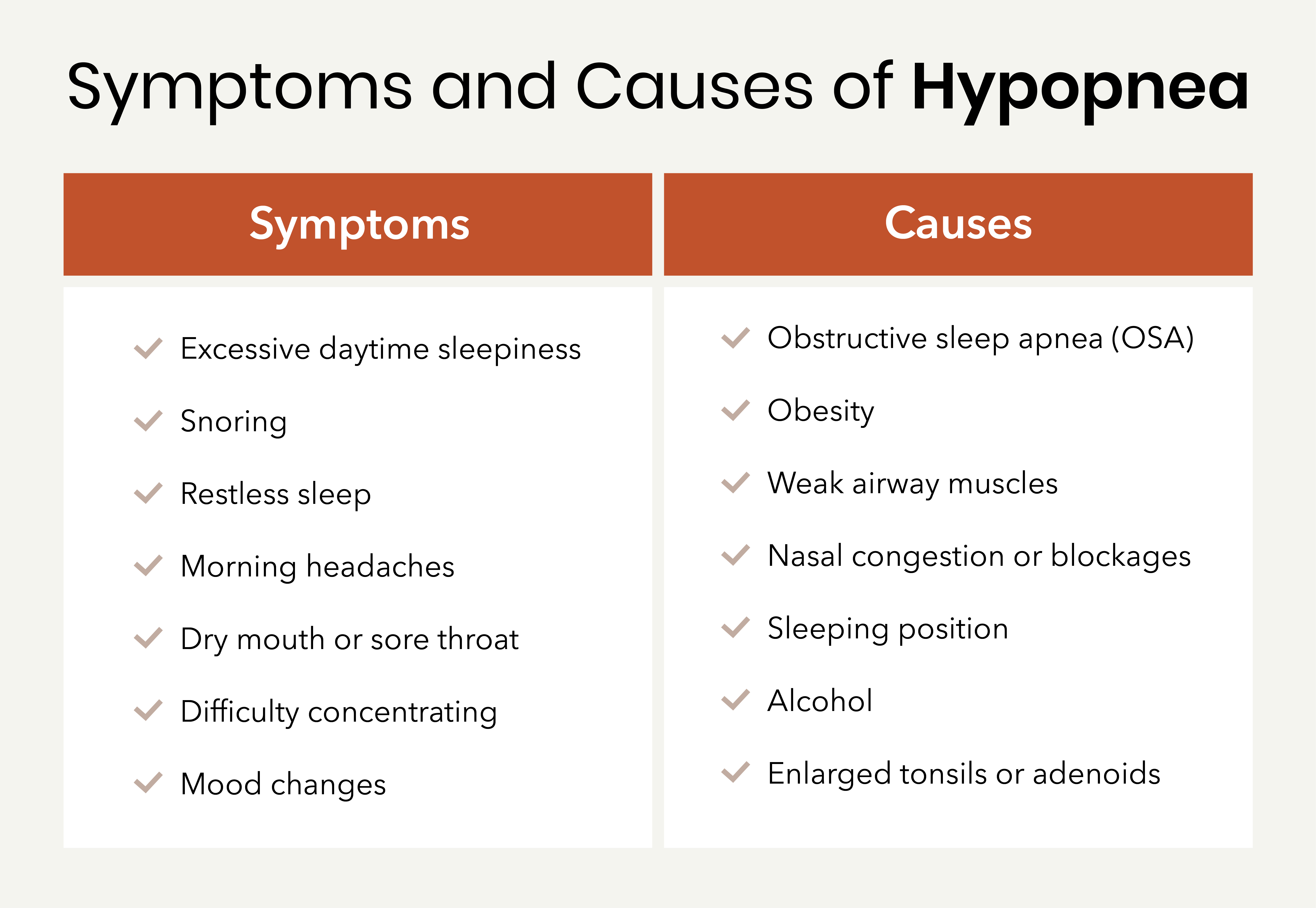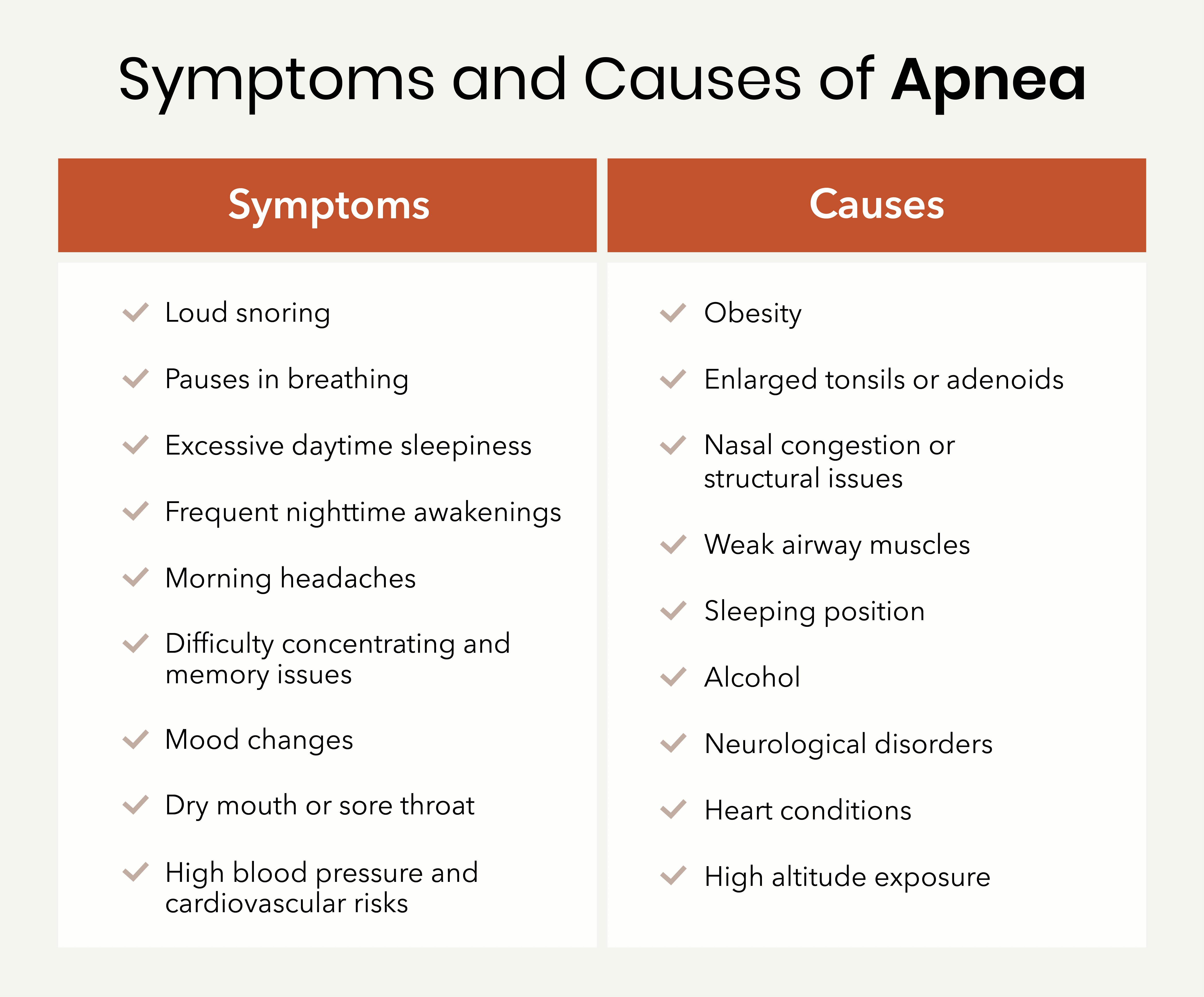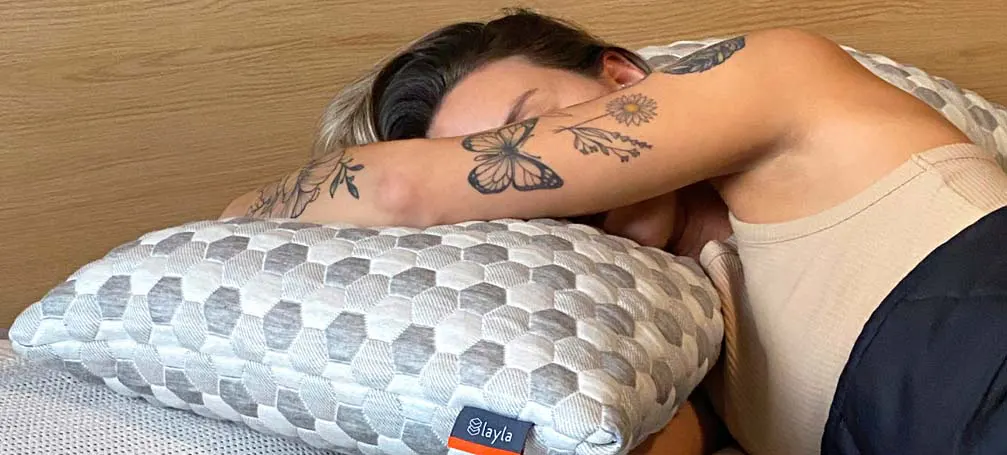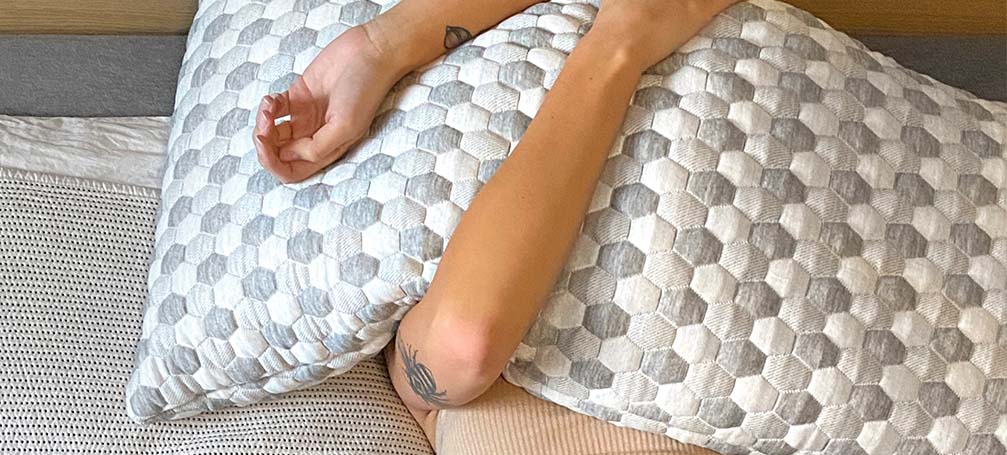In this guide, we explore the differences between hypopnea vs. apnea and what you can do if you have either one of these sleep disorders.
- Key Takeaways
- What Is Hypopnea?
- What Is Apnea?
- Key Differences Between Hypopnea vs. Apnea
- How Are Apnea and Hypopnea Diagnosed?
- How Do You Treat Hypopnea and Apnea?
- Wrapping Up: Achieving Better Sleep with Hypopnea and Apnea
Key Takeaways
- Hypopnea involves particularly reduced airflow during sleep, while apnea is a complete pause in breathing.
- Both conditions share symptoms like excessive daytime sleepiness, though apnea symptoms are typically more severe.
- Side sleeping is generally recommended for both conditions, as back sleeping can worsen symptoms.
- Treatment options for hypopnea and apnea range from lifestyle changes and CPAP therapy to surgery and oral appliances.
What Is Hypopnea?
Hypopnea is a condition in which someone experiences shallow breathing or partially reduced airflow when they’re asleep. Unlike apnea, which is a complete pause in breathing, hypopnea means you’re still breathing, just not getting enough air. According to sleep specialists, hypopnea typically involves at least a 30% reduction in airflow for a minimum of 10 seconds, along with a decrease in blood oxygen levels.[1]
Symptoms of hypopnea
People with hypopnea often don’t realize they have a breathing problem until symptoms start affecting their daily life or a sleep partner notices their breathing patterns. Common symptoms of hypopnea are:[2]
- Excessive daytime sleepiness: Despite spending a full night in bed, you might feel tired throughout the day because your sleep quality is poor. This can make it hard to stay alert at work or while driving.
- Snoring: Snoring frequently accompanies hypopnea, though it’s usually not as severe as with apnea. The snoring may include occasional gasping sounds as your body works harder to breathe.
- Restless sleep: You might toss and turn throughout the night without knowing why or experience restless leg syndrome due to a lack of oxygenated blood in the legs.
- Morning headaches: If you have hypopnea, you may wake up with a headache due to your brain not receiving enough oxygen during sleep. However, these headaches typically fade as the day goes on.
- Dry mouth or sore throat: You might wake up with these symptoms from breathing through your mouth during sleep, especially if you have nasal congestion.
- Difficulty concentrating: Many people with hypopnea find themselves forgetting things or unable to focus on tasks during the day because they’re so tired.
- Mood changes: Irritability or feeling down can develop when you’re not getting quality sleep night after night.

Causes of hypopnea
Several factors can contribute to hypopnea, and often more than one is involved. Potential causes of hypopnea include:[3]
- Obstructive sleep apnea (OSA): Hypopnea and OSA frequently occur together. When doctors talk about apneas and hypopneas, they’re referring to these related breathing events that happen during sleep.
- Obesity: Excess weight around your neck and throat puts pressure on your airway. Even modest weight gain can increase your risk of developing hypopnea.
- Weak airway muscles: Muscles that relax too much during sleep can partially collapse your airway. This becomes more common as we age.
- Nasal congestion or blockages: Nasal congestion at night or structural issues, such as a deviated septum, can force mouth breathing and increase hypopnea episodes.
- Sleeping position: Sleeping on your back often makes hypopnea worse because gravity pulls your tongue and soft tissues backward. Research has found that the best position to sleep for those with hypopnea and apnea is side sleeping.
- Alcohol: Alcohol can affect your sleep by relaxing your airway muscles and inflaming blood vessels in the nose, which can worsen breathing problems throughout the night.
- Enlarged tonsils or adenoids: Particularly in children, enlarged tonsils or adenoids can partially block the airway and cause hypopnea.
What Is Apnea?
Apnea is more severe than hypopnea and involves complete pauses in breathing during sleep. These breathing pauses typically last at least 10 seconds and can happen dozens of times per night.[4] Sleep apnea comes in three main types:[3]
- Obstructive sleep apnea: This is the most common type of sleep apnea and is caused by a physical blockage of the airway that occurs when throat muscles relax.
- Central sleep apnea: This type of apnea happens when your brain doesn’t send the right signals to your breathing muscles, which causes you to stop breathing.
- Mixed sleep apnea: This type of apnea combines features of both obstructive and central sleep apnea.
Symptoms of apnea
The symptoms of apnea overlap with hypopnea and are typically more pronounced. Common symptoms include:[3]
- Loud snoring: Snoring is the most obvious symptom and often prompts people to seek help. Partners may complain they can hear the snoring from another room. The snoring is typically loud and persistent and may include choking or gasping sounds.
- Pauses in breathing: These frightening episodes can last from 10 seconds to over a minute. Pauses in breathing can occur dozens of times per night.
- Excessive daytime sleepiness: This goes beyond normal tiredness and can severely impact your daily life. You might find yourself nodding off during conversations, while watching TV, or, even more dangerously, while driving. This chronic fatigue occurs because your sleep is constantly disrupted by breathing problems.
- Frequent nighttime awakenings: People with apnea often experience waking up several times throughout the night, though they may not remember them. These brief arousals happen when the brain senses breathing has stopped.
- Morning headaches: These can be intense due to the oxygen deprivation that occurs throughout the night. Unlike tension headaches, these headaches tend to improve as the day progresses and your oxygen levels normalize.
- Difficulty concentrating and memory issues: Many people experience cognitive impairment that affects work performance and daily activities. You might struggle to complete familiar tasks, forget important information, or find it difficult to focus on conversations or reading materials. This “brain fog” is directly linked to poor sleep quality and reduced oxygen to the brain.
- Mood changes: Untreated apnea often leads to irritability, depression, and anxiety that can strain relationships. Many people notice significant mood improvements after treatment begins.
- Dry mouth and/or sore throat: Waking up with a parched mouth, scratchy throat, or bad breath happens because you’re breathing through your mouth all night. This chronic mouth breathing can lead to increased dental problems and throat infections over time.
- High blood pressure and cardiovascular risks: Apnea puts tremendous stress on your heart and blood vessels, significantly raising your risk of hypertension, heart attack, and stroke. The oxygen drops and stress hormone spikes that occur during apnea episodes force your heart to work harder and can lead to dangerous rhythm problems.

Causes of apnea
Many of the causes of apnea are similar to hypopnea but with some key differences:[5]
- Obesity: The leading risk factor for obstructive sleep apnea is obesity, with risk increasing significantly with higher BMI.
- Enlarged tonsils or adenoids: These can completely block the airway during sleep, especially in children.
- Nasal congestion or structural issues: Nasal congestion, structural issues like a deviated septum, and allergies at night can force mouth breathing and contribute to apnea episodes.
- Weak airway muscles: Muscles that completely collapse during sleep lead to obstructive apnea episodes.
- Sleeping position: How you sleep can affect how your breathing muscles relax at night. When it comes to sleep positions for sleep apnea, side sleeping is often recommended.
- Alcohol: Alcohol and sedative medications can relax your throat muscles, triggering or worsening apnea episodes.
- Neurological disorders: Central sleep apnea can be caused by conditions that affect breathing control, including stroke and Parkinson’s disease.
- Heart conditions: Problems like heart failure can lead to central sleep apnea due to increased filling pressure that causes congestion.
- High altitude exposure: This can trigger sleep apnea in some people, even those who don’t normally have breathing issues at lower elevations due to reduced oxygen levels, increased respiratory rate, and changes in airway pressure in high altitudes.[6]
Key Differences Between Hypopnea vs. Apnea
Though hypopnea and apnea often go hand-in-hand, understanding their differences can help you better grasp what might be happening during your sleep. Think of it this way: with hypopnea, your airway is like a garden hose that’s been partially stepped on — water still flows, but not at full capacity. With apnea, it’s as if someone completely pinched the hose shut, and water stops flowing entirely.
Here are the key differences between hypopnea vs. apnea:
- Symptoms: While both conditions share many symptoms, apnea typically produces more dramatic nighttime signs. You’ll likely experience louder snoring with complete silence during breathing pauses, followed by more pronounced gasping or choking sounds.
- Causes: The risk factors overlap significantly for both conditions and include obesity, sleeping position, and anatomical features. However, sleep apnea brings additional triggers into the mix, including heart failure and even sleeping at high altitudes.
- Airway obstruction: Hypopnea involves a partial blockage of your airway, reducing airflow. On the other hand, apnea involves complete or near-complete cessation of airflow, meaning your airflow is essentially blocked completely.
- Oxygen levels impact: With hypopnea, your blood oxygen levels experience mild to moderate drops. Apnea causes much steeper drops, which can put more strain on your cardiovascular system and brain.
How Are Apnea and Hypopnea Diagnosed?
Both apnea and hypopnea are diagnosed through similar means, with the gold standard being a polysomnography or sleep study.[7] During this test, you’ll sleep overnight at a sleep lab where specialists monitor your:[8]
- Brain waves
- Heart rate and rhythm
- Breathing patterns
- Blood oxygen levels
- Body movements
The results will include your Apnea-Hypopnea Index (AHI), which counts the combined number of apneas and hypopneas per hour of sleep. This score helps determine severity:[7]
- Mild: 5-15 events per hour
- Moderate: 15-30 events per hour
- Severe: More than 30 events per hour
Your doctor may also review your medical history, examine your airway, and possibly order blood tests to rule out other conditions that could explain your symptoms.
How Do You Treat Hypopnea and Apnea?
Treatment approaches for both conditions share many similarities, with options ranging from simple lifestyle changes to medical interventions, such as: [3,4]
Lifestyle changes: Weight loss can significantly improve symptoms if you’re overweight. Avoiding alcohol and sedatives before sleep can also help keep your airway muscles from relaxing too much.
Changing sleep positions: Side sleeping is generally best, while back sleeping can worsen both conditions. Some people find that sleeping on your stomach helps, though this position can cause neck and back discomfort.
CPAP therapy: Continuous Positive Airway Pressure is the best treatment option for moderate to severe cases. A CPAP machine delivers pressurized air via a mask to keep your airway open during sleep.
Oral appliances: These dental devices can help mild to moderate cases by repositioning your jaw or tongue to keep your airway more open during sleep. They’re less obtrusive than CPAP but typically less effective for severe cases.
Mouth taping: Some people find relief with mouth taping for sleep, a technique that encourages nasal breathing. While not suitable for everyone, it can help those who primarily breathe through their mouth.
Surgery: For severe cases that don’t respond to other treatments, options range from removing enlarged tonsils to more extensive procedures that reposition the jaw or reduce excess tissue in the throat.
Wrapping Up: Achieving Better Sleep with Hypopnea and Apnea
Understanding the difference between apnea vs. hypopnea is just the first step toward better sleep. Getting diagnosed and following your doctor’s treatment plan can dramatically improve your quality of life. Don’t ignore symptoms like excessive daytime sleepiness or loud snoring.
Your sleep environment matters, too, and that’s where Layla can help. The right mattress can help you find the best sleep positions to reduce breathing problems at night. Layla’s Memory Foam Mattress provides contouring support that can help keep your airway aligned, while the Hybrid Mattress offers additional support by combining the powers of dual-gauge pocked coils and memory foam. Browse our selection of sleep products today.
References
- Berry, Richard B, et al. “A Transition to the American Academy of Sleep Medicine–Recommended Hypopnea Definition in Adults: Initiatives of the Hypopnea Scoring Rule Task Force.” Journal of Clinical Sleep Medicine, vol. 18, no. 5, 24 Feb. 2022, pp. 1419–1425, jcsm.aasm.org/doi/10.5664/jcsm.9952.
- “Hypopnea: Definition, Symptoms, and Causes | SleepApnea.org.” SleepApnea.org, 4 Nov. 2022, www.sleepapnea.org/hypopnea/ “Sleep Apnea: What It Is, Causes, Symptoms & Treatment.” Cleveland Clinic, 30 Aug. 2023, my.clevelandclinic.org/health/diseases/8718-sleep-apnea#symptoms-and-causes.
- “Obstructive Sleep Apnea.” Hopkinsmedicine.org, 29 July 2024, www.hopkinsmedicine.org/health/conditions-and-diseases/obstructive-sleep-apnea.
- “Sleep Apnea – Symptoms and Causes.” Mayo Clinic, 2025, www.mayoclinic.org/diseases-conditions/sleep-apnea/symptoms-causes/syc-20377631.
- Pagel, J.F., et al. “The Effects of Altitude Associated Central Apnea on the Diagnosis and Treatment of Obstructive Sleep Apnea: Comparative Data from Three Different Altitude Locations in the Mountain West.” Journal of Clinical Sleep Medicine, vol. 07, no. 06, 15 Dec. 2011, pp. 610–615, pmc.ncbi.nlm.nih.gov/articles/PMC3227706/, https://doi.org/10.5664/jcsm.1462.
- “Apnea-Hypopnea Index (AHI).” SleepApnea.org, Mar. 2023, www.sleepapnea.org/diagnosis/ahi-apnea-hypopnea-index.
- “Sleep Studies.” SleepApnea.org, 14 Dec. 2022, www.sleepapnea.org/diagnosis/sleep-studies/.


